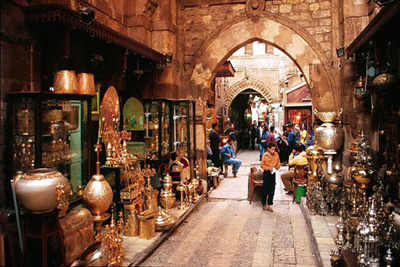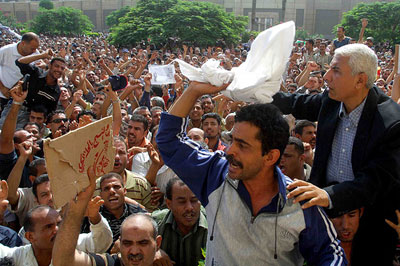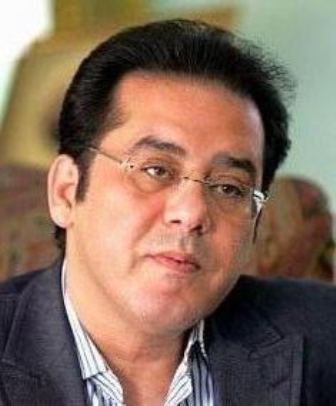Thoughts on the Middle East, History and Religion
Why Egypt 2011 is not Iran 1979
Posted on 02/02/2011 by Juan
Alarms have been raised by those observing the popular uprising in Egypt that, while it is not itself a Muslim fundamentalist movement, the Muslim fundamentalists could take it over as it unfolds. The best-positioned group to do so is the Muslim Brotherhood. Some are even conflating the peaceful Brotherhood with radical groups such as al-Qaeda. I showed in my recent book, Engaging the Muslim World, that the Muslim Brotherhood has since the 1970s opposed the radical movements. In any case, the analogy many of these alarmists are making, explicitly or implicitly, is to Iran in 1978-79, which saw similar scenes of massive crowds in the street, demanding the departure of Mohammad Reza Shah Pahlavi, their king.
Misagh Parsa argued that the revolution of 1978-79 was made by several different social groups, each for its own reasons. The revolution was fought against the monarchy, which presided over an oil-exporting economy that had gone into overdrive because of the big fourfold run-up of prices in the 1970s. Many felt that they were not sharing in that prosperity, or were inconvenienced by the Shah’s authoritarian government.
1. THE BAZAAR: The bazaar is a way of referring to the old business and artisan classes who congregated in covered bazaars and around mosques and courts in the older part of Iranian cities. Everyone from tinsmiths, to moneylenders, to carpet import-export merchants is encompassed by the phrase. The bazaar came to be in significant competition with the new business classes (importers of tin pans were putting the tinsmiths out of business, and modern banking was making inroads against the moneylenders). The bazaar had many links with the ayatollahs in mosques and seminaries, including via intermarriage. The Shah despised the bazaar as a bastion of feudal backwardness, and imposed onerous taxes and fines on it, in addition to casually destroying entire bazaars, as at Mashhad. THE BAZAAR FAVORED THE CLERGY AND BANKROLLED THE REVOLUTION.
2. WHITE AND BLUE COLLAR WORKERS: Industrial and oil workers struck over their wages and labor conditions. School teachers and white collar professionals (nurses, physicians, etc.) protested the lack of democracy.
3. SECULAR PARTIES: The old National Front of the early 1950s movement for oil nationalization was weak and aging but still significant. The Communist Party was much less important than in the 1950s but still had some organizational ability. Left-leaning youth radicals, such as the Fedayan-i Khalq (which leaned mildly Maoist) had begun guerrilla actions against the regime. There were also secular intellectuals in what was called the Writer’s Movement.
4. RELIGIOUS FORCES: The religious forces included not only the clergy and mosque networks of dissidents such as Grand Ayatollah Ruhollah Khomeini (in exile in Najaf, Iraq and then Paris), but also religious party-militias such as the Mujahedin-e Khalq (MEK: Fighters for the People). In Shiite Islam, a doctrine had grown up that laypersons owe implicit obedience to the clergy when the latter rule on the practice of religious law. Ayatollahs have a place of honor not common for Sunni clergy.
Parsa argues, I think correctly, that the religious forces were initially only one of the important social groups that made the revolution, but of course they ultimately hijacked it and repressed the other three. Note that although the rural population was the majority in Iran at that time, it was little involved in the revolution, though it was very well represented in the subsequent revolutionary parliament and so benefited from new rounds of road, school and other building in the 1980 and 1990s.
Egypt is, unlike Iran, not primarily an oil state. Its sources of revenue are tourism, Suez Canal tolls, manufactured and agricultural exports, and strategic rent (the $1.5 bn. or so in aid from the US comes under this heading). Egypt depends on the rest of the world for grain imports. Were it to adopt a radical and defiant ideology like that of Iran, all its major sources of income would suddenly evaporate, and it might have trouble even just getting enough imported food. Moreover, the social forces making the revolution in Egypt have a significantly different profile and different dynamics than in Iran. Let us just go through the same list.
1. THE BAZAAR: To the extent that there is a bazaar (the Arabic would be suq) in Egypt, it is by now very heavily dependent on the tourist trade. Coptic Christians are well represented in it. The suq therefore tends to oppose social policies that would scare away Western tourists. The suq will do very badly this year because of the turmoil. One merchant in Khan al-Khalili once told me that the bad years for his business had been 1952, 1956, 1967, 1973– the years of the revolution and then the Arab-Israeli wars that would have been celebrated by nationalists but which he regretted.. Because few tourists came those years. That the Egyptian Market would bankroll Egyptian fundamentalists to establish an oppressive theocracy that would permanently scare away German holiday-makers is highly unlikely.
2. WHITE AND BLUE COLLAR WORKERS: These groups are among the primary instigators of the Egyptian uprising. The April 6 group of young labor activists first came to prominence when they supported strikes by textile factory workers in Mahalla al-Kubra and elsewhere for improved wages and work conditions. There have been more than 3,000 labor actions by Egyptian workers since 2004. The pro-labor youth activists have been among the major leaders of the uprising in the past week, and had pioneered the use of Facebook and Twitter for such purposes.
3. SECULAR FORCES. When I say ‘secular’ with regard to Egypt, I do not mean that these groups are made up of atheists and agnostics. Their members may go to mosque and pray and be personally pious. But such people can nevertheless vote for parties that are not primarily organized around religion. These include the New Wafd Party, a revival of the old liberal party that dominated Egypt 1922-1952 during its “liberal” period of parliamentary elections and prime ministers. The Wafd had originally represented the interests of great landlords and budding bankers and industrialists, though its original role in fighting for independence from Britain also gave it popular support. It reemerged when Egypt began turning away from Gamal Abdel Nasser’s socialism and it again championed private property rights. It attracted the allegiance of many Copts, as well as middle class Muslims. Although it has suffered divisions and declining popularity in recent elections, in a situation of free and fair elections it could regain some popularity. Then there is the Tomorrow (al-Ghad) party of Ayman Nur, who won 8% of the vote in the 2005 presidential election. And there is the Kefaya! (Enough!) movement. All three favor human rights and parliamentary democracy. There are also many secular figures in the literary establishment and in the film world (such as comic Adil Imam). And, of course, there is the ruling National Democratic Party, which has a generally secular bias and dislikes Muslim fundamentalism. Whether it can overcome its association with Hosni Mubarak and continue to contest elections credibly remains to be seen. It is now by far the dominant party in parliament, though nobody thinks the elections were free and fair.
4. THE RELIGIOUS FORCES: Unlike in Iran, there are relatively few prominent dissident clergy. “Televangelist” Yusuf al-Qaradawi, in exile in Qatar, should be counted among them. The Egyptian state had for the most part nationalized mosques and controlled the clerical corps. Few Egyptian clergyman command the respect or obedience of the laity to the extent that Khomeini did in Iran. The major religious party is the Muslim Brotherhood, founded in 1928. Although it developed a terrorist wing in the 1940s, it faced severe crackdowns in the 1950s and 1960s, and lost that capacity. Although the radical thinker Sayyid Qutb came out of their movement, the MB leadership disowned him in the late 1960s and even refuted his radical doctrines (such as declaring other Muslims with whom he disagreed to be ‘non-Muslims’) as “un-Sunni.” By the 1970s the Brotherhood’s leaders were willing to make their peace with the government of Anwar El Sadat. He let them operate if they agreed not to resort to violence and not to try to overthrow the government. In the 1990s, the Brotherhood came to counter the radical movements, such as the Egyptian Islamic Jihad, and so had a tacit partnership with the state. Egypt does not allow parties to be organized on the basis of religion, but even so Muslim Brother candidates have done well in some parliamentary elections (especially 2006), running under the rubric of other parties.
So to recapitulate. The white collar and labor activists are far more central to the organization of the Egyptian protests than had been their counterparts in the Iranian Revolution. The Egyptian “bazaar” is much less tied to the Muslim clergy than was the case in Iran, and far less likely to fund clerical politicians. Whereas Iran’s bazaar merchants often suffered from Western competition, Egypt’s bazaar depends centrally on Western tourism. Secular parties, if we count the NDP, have an organizational advantage over the religious ones, since they have been freer to meet and act under Mubarak. It is not clear that the law banning religious parties will be changed, in which case the Brotherhood would again be stuck with running its candidates under other rubrics. And, Sunni Muslims don’t have a doctrine of owing implicit obedience to their clergy, and the clergy are not as important in Sunni religious life as the Shiite Ayatollahs are in Iran. The Muslim Brotherhood, a largely lay organization, has a lot of support, but it is not clear that they could gain more than about a third of seats even if they were able to run in free elections.
One of the sources of the Muslim Brotherhood’s popularity was its opposition to Mubarak, and it may actually lose followers without him around. Other religious politicians and entrepreneurs may proliferate, in a freer atmosphere, dividing the religious section of the electorate. And, the Brotherhood could well evolve to be more like Turkey’s Justice and Development [AK] Party than like its old, sectarian, underground self. There is nothing in MB ideology that forbids participation in parliamentary democracy, even though it was not exactly a big theme of its founder, Hasan al-Banna.
Some analysts read off support for the MB from Egyptians’ religiosity. Egyptians have been undergoing a religious revival in the past couple of decades. You have to think about them like southern evangelicals in the US. When I am in Egypt it reminds me a lot of South Carolina in that regard. But that people go to mosque, or that their women wear headscarves, or that they value religion, does not necessarily translate into them voting for a sectarian and somewhat cliquish group like the Muslim Brotherhood. Many pious Muslims are factory workers and so closer to April 6 than to the Brotherhood. Many women who wear headscarves do so to legitimate their entry into the modern labor force and appearance in the public sphere. National identity co-exists with the religious. Egyptians are also great nationalists, and many insist that the Egyptian nation is a framework within which Christian Copts are completely legitimate participants.
A recent Pew poll found that 59% of Egyptians favor democracy in almost all situations. And fully 60 percent are very or somewhat worried about the specter of religious extremism in their society. About 61% do not even think there is a struggle between modernizers and religion in Egypt.
Among the 31% who did see such a struggle, 59% favored religious forces and 21% favored the modernizers. Barry Rubin and Michael Totten misread this latter statistic to be true of all Egyptians. They are wrong. The statistic is not about Egyptians in general, but about the third of them who see a conflict between modernizers and religion. 59% of 31% is 18% of the whole Egyptian population who favor fundamentalists over modernizers. The rest either favor the modernizers or think it is a phony conflict. Not thinking that modernism and religiosity conflict is generally a liberal point of view.
It cannot be assumed that the Muslim Brotherhood is the future face of Egypt, and there is no reason to think it has the popularity or levers of power that would allow it to make a coup. The Brothers are more likely to gain further influence (as they already have since 2006) via parliamentary elections. I cannot, of course, know whether there will be new parliamentary elections in Egypt soon, whether the Muslim Brotherhood will be allowed to run, or how well, exactly, they will do. They would likely be far more influential in a democratic Egypt than they have been under Mubarak, but I cannot see what would make them hegemonic. They would want liquor to be banned throughout the country, e.g. which would be very bad for tourism, and a lot of Egyptians depend on tourism. Of course, social groups sometimes do go in directions that irrationally harm their economic interests. But the Cassandras have no proof that Egyptians will take that path.


